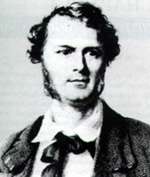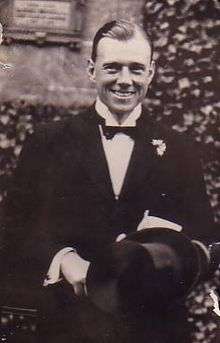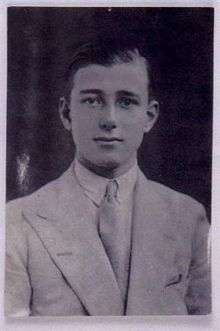White Rajahs
- Other men sometimes referred to as White Rajahs include Englishman Alexander Hare in Borneo, Scot John Clunies Ross in the Cocos Islands, and Dane Mads Lange in Bali. For the book by Nigel Barley, see Nigel Barley (anthropologist)
| Rajah of Sarawak | |
|---|---|
|
Coat of arms | |
|
HH James Brooke, Rajah of Sarawak | |
| Details | |
| Style | His Highness |
| First monarch | James Brooke |
| Last monarch | Charles Vyner Brooke |
| Formation | 1841 |
| Abolition | 1946 |
| Residence | The Astana |
| Pretender(s) | James Brooke |
The White Rajahs were a dynastic monarchy of the English Brooke family, who founded and ruled the Kingdom of Sarawak, located on the island of Borneo, from 1841 to 1946. The first ruler was Englishman James Brooke. As a reward for helping the Sultanate of Brunei fight piracy and insurgency among the indigenous peoples, he was granted the landmass of Sarawak in 1841 and received independent kingdom status.
Based on descent through the male line in accordance with the Will of Sir James Brooke, the White Rajahs' dynasty continued through Brooke's nephew and grandnephew, the latter of whom ceded his rights to the United Kingdom in 1946. His nephew had been the legal heir to the throne and objected to the cession, as did most of the Sarawak members of the Council Negri.
Rulers
Sarawak was part of the realm of Brunei until 1841 when James Brooke was granted a sizeable area of land in the southwest area of Brunei – around the city of Sarawak (now Kuching) and the nearby mining region of Bau – from Bruneian Sultan Omar Ali Saifuddin II. He was later confirmed with the title of Rajah of the territory. The Kingdom of Sarawak developed and expanded during the rule of the first two White Rajahs, growing to occupy much of the north region of the island of Borneo. The Brooke administrations leased or annexed more land from Brunei.
The White Rajahs were all related:
| Name | Portrait | Birth | Death | Marriages | Succession right | Note |
|---|---|---|---|---|---|---|
| James of Sarawak (James Brooke) (1841–1868) |  | 29 April 1803, India | 11 June 1868, England | unmarried, but acknowledged an illegitimate son | granted Sarawak and the title Rajah by the Sultan of Brunei | |
| John Brooke Johnson/Brooke, Rajah Mudah of Sarawak (1859–1863) |  | 1823, England | 1 December 1868, England | Anne Grant, children: Basil, John Evelyn Hope Julia Wellstead, child: Matilda Agnes | His uncle James regarded him as heir from at least 1848, formally installed him as Rajah Mudah in 1859, but disinherited him for what he termed 'treason' | |
| Charles of Sarawak (Charles Johnson/Brooke) (1868–1917) |  | 3 June 1829, England | 17 May 1917, England | Dayang Mastiah, one illegitimate son Margaret Alice Lili de Windt, with whom he had six children; three (including his son Charles) survived infancy | His uncle James named Charles as his successor in 1865 | |
| Vyner of Sarawak (Charles Vyner Brooke) (1917–1946) |  | 26 September 1874, England | 9 May 1963, England | Sylvia Brett, with whom he had three daughters | son of the preceding, inherited the title | |
| Bertram of Sarawak (Bertram Brooke) Tuan Muda of Sarawak (1917–1946) |  | 8 August 1876, Sarawak | 15 September 1965, England | Gladys Palmer, with whom he had three daughters and one son | brother of the preceding | |
| Anthony of Sarawak (Anthony Brooke) Rajah Muda of Sarawak (1939–1951) |  | 10 December 1912, England | 2 March 2011, New Zealand | Kathleen Hudden, with whom he had two daughters and one son | son of the preceding |
James and Charles had short grammar school educations, Vyner, Bertram, and Anthony went to public schools and Cambridge University (but without taking degrees). All but Anthony died in England and are buried at Sheepstor parish church, Devon. Anthony Brooke had his ashes interred at Sheepstor as well as at the Brooke Family graveyard in Kuching, as per his last wish.
The White Rajahs pursued a policy of paternalism, with the goal of protecting the "native peoples" (indigenous peoples) from "capitalist exploitation". While James Brooke laid much of the groundwork for the expansion of Sarawak, his nephew Charles, the second rajah, was the great builder. He constructed public buildings to serve welfare, such as a hospital, in addition to forts. He worked to extend the borders of the state.
Vyner Brooke instituted significant political reforms during his tenure. He ended the absolute rule of the Rajah in 1941, before the Japanese invasion of World War II, by granting new powers to the Council Negri (the parliament). Bertram co-ruled with his elder brother, taking turns of 6 – 8 months in charge of the country each year. By 1939 Bertram's son Anthony had taken the reins of government, and it was with considerable controversy that Vyner attempted to cede Sarawak to Britain secretly in 1946 in what gave rise to the anti-cession movement of Sarawak.
Titles
Rajah Mudah (later written 'Muda') was the title given to the heir apparent of the Rajah of Sarawak, and the style "His Highness". The wife of the Rajah Muda(h) had the title Ranee Muda(h).
Government

When James Brooke first arrived in Sarawak, it was governed as a vassal state of the Sultanate of Brunei; the system of government was based on the Bruneian model. Brooke reorganised the government according to the British model, eventually creating a civil service. It recruited European, chiefly British, officers to run district outstations. The Sarawak Service was continually reformed by Rajah James and his successors.
Rajah James retained many of the customs and symbols of Malay monarchy, and combined them with his own style of absolute rule. The Rajah had the power to introduce laws and acted as chief judge in Kuching.
The White Rajahs were determined to prevent the indigenous peoples of Sarawak from being exploited by Western business interests. They allowed the Borneo Company Limited (the Borneo Company) to assist in managing the economy. The core of the early Sarawak economy was antimony, later followed by gold, which was mined in Bau by Chinese syndicates who imported numerous workers from China.[1] After the local Chinese uprising in 1857,[2] the mining operations were gradually taken over by the Borneo Company; it bought out the last Chinese syndicate in 1884.[1] The Borneo Company provided military support to the White Rajahs during crises such as the Chinese uprising. One of the company steamships, the Sir James Brooke, helped recapture Kuching.
Rajah Charles formed a small paramilitary force, the Sarawak Rangers, to police and defend the expanding state. This small army also manned a series of forts around the country, acted as the Rajahs' personal guard, and performed ceremonial duties.
Cession to the United Kingdom
After the Second World War, during which Sarawak and Borneo had been occupied by Japanese forces, the third rajah, Vyner Brooke, ceded his life interest in Sarawak to the Colonial Office. In exchange, he received a sizeable pension for him and his three daughters. Unclear as to the legality of cession, the British Government simultaneously passed a Bill of Annexation. Rajah Vyner's nephew and legal heir, Anthony Brooke, initially opposed annexation by the Crown, as did a majority of the native members of the Council Negri.
Because of his opposition to the cession, Anthony Brooke was considered a suspect when Duncan Stewart, the second British governor to Sarawak, was assassinated by two people that were believed to be members of a group dedicated to restoring him as Rajah.[3] In fact they were from a political group agitating for union with newly independent Indonesia.[3] He was never prosecuted. Documents released in the late 20th century indicate that the British Government knew that Brooke was not involved, but chose not to reveal the truth of the matter so not to provoke Indonesia. It had recently won its war of independence from the Netherlands, and the UK was already dealing with the Malayan Emergency to the north-west.[3][4] Since those events, there has been no serious movement for the restoration of the monarchy, although Anthony's son James Bertram Lionel Brooke remains the principal beneficiary (heir) under the Will of Sir James Brooke.
The period of Brooke rule is generally looked upon favourably in Sarawak, and in recent times the government has accepted the importance of their legacy for its social, cultural, and touristic value.
The Brooke family still maintains strong ties to the state and its people and are represented by the Brooke Trust, and by Anthony Brooke's grandson Jason Desmond Anthony Brooke, at many state functions and supporting heritage projects.
Legacy
- The coaling station of Brooketon in Brunei was named after the Brooke family.
- The architectural legacy of the dynasty can be seen in many of the country's 19th-century and colonial heritage buildings. In Kuching these include the Astana, or governor's residence; the Sarawak Museum, the Old Courthouse, Fort Margherita, the Square Fort, and Brooke Memorial. The Brooke Dockyard, which was founded in the period of Rajah Charles, is still in operation, as is the original Sarawak Museum. Several key buildings from the Brooke period, such as the offices and warehouses of Borneo Company, have been demolished for more recent developments.
Modern Kuching has many businesses and attractions that refer to the era of the White Rajahs:
- The James Brooke Café and the Royalist, a pub named after James Brooke's schooner, refer to the history of the Brookes.
Sarawak is notably different from peninsular Malaysia and even Sabah (the neighbouring Malaysian state also located on Borneo), as it has a more diverse population. It has a large proportion of indigenous tribal peoples, such as the Iban and Dyaks. In addition, it received numerous Chinese and Indian immigrants, whose businesses and labour were encouraged at various times by the White Rajahs.
Heraldry and emblems
.svg.png)
The heraldic arms of the Brooke dynasty were based on the emblem used by James Brooke. It consisted of a red and black cross on yellow shield, crested by a badger, known in heraldic parlance as a "brock" and hence alluding to the dynastic surname. A crown was added in 1949, and the shield design was used as the basis of the Sarawak flag until 1973. In 1988 the state flag reverted to these original colours.
References
- 1 2 Kaur, Amarjit (February 1995). "The Babbling Brookes: Economic Change in Sarawak 1841–1946". Modern Asian Studies. Cambridge University Press. 29 (1): 65–109, 73. doi:10.1017/s0026749x00012634. ISSN 0026-749X.
- ↑ Chew, Daniel (1990). Chinese Pioneers on the Sarawak Frontier 1841–1941. Singapore: Oxford University Press. ISBN 0-19-588915-0.
- 1 2 3 Mike Thomson (14 March 2012). "The stabbed governor of Sarawak". bbc.co.uk. BBC News. Retrieved 2016-11-04.
- ↑ Mike Thomson (12 March 2012). "Radio 4's investigative history - The stabbed governor of Sarawak". bbc.co.uk. BBC News. Retrieved 2016-11-04.
- Ranee Margaret of Sarawak (2001). My Life in Sarawak. Oxford: Oxford University Press. ISBN 0-19-582663-9.
- Sylvia, Lady Brooke (1970). Queen of the Headhunters.
- Eade, Philip (2007). Sylvia, Queen of the Headhunters: A Biography of Lady Brooke, the Last Ranee of Sarawak. London: Weidenfeld & Nicolson.
- Reece, R.H.W. (1993). The Name of Brooke: The End of White Rajah Rule in Sarawak.
- Runciman, Steven (1960). The White Rajahs: A History of Sarawak from 1841 to 1946. Cambridge: Cambridge University Press.
- Schutte, O (1981). "M. R. H. Calmeyer, de Wind, de Windt, de Wint". De Nederlandsche Leeuw. p. 23.
- "Quast". Nederlandse Genealogieen. 11. Den Haag: Koninklijk Genootschap voor Geslacht- en Wapenkunde. 1996. (Literature regarding Broek-De Wind)
External links
- brooketrust.org
- Old Rajah Brooke website (snapshot from 9 June 2009)
- A Sarawak Royal Interest Homepage
- bbc.co.uk

_by_Francis_Grant.jpg)